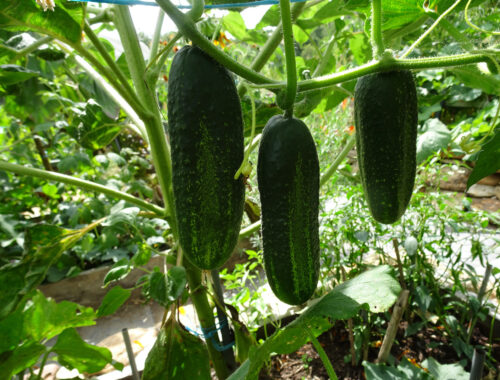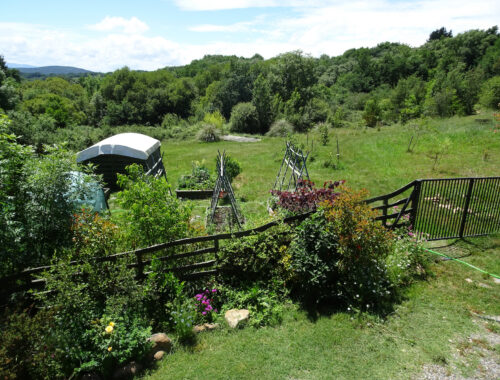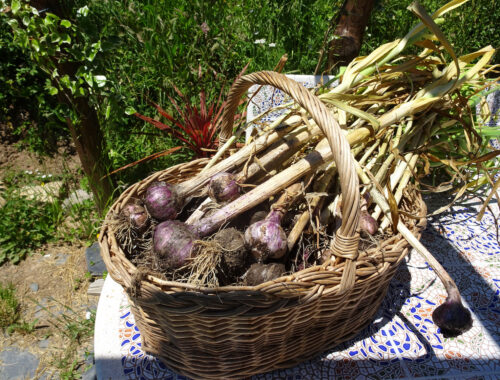
Medusa’s Garden
Our kitchen garden is really Medusa’s Garden, the orchard and the areas around and in between. Why Medusa? Because that’s a name for the primordial serpent energy of the land and there’s that wildness here. If the land doesn’t like what we’re doing, she’ll let us know. We still have a lot to learn.
Our property is a large area for us to manage and it’s tough going, with solid clay, brambles and scrubby grass and we need as much help from Nature as we can get. The kitchen garden is our main larder for vegetables and herbs and we bowed to the need for something close by and manageable. The orchard is slowly emerging, getting enough water there and protecting the young trees from deer and boar is a challenge. It would be good to have a shady space to hang a hammock in the summer.
We had lots of ideas about how we wanted to live when we moved here, gradually we’ve ditched most systems and started to let the land do as she wants as much as possible, while carving out spaces for our needs and giving a nudge here and there. We still follow some of the permaculture principles and we tried and failed to grow a food forest. We don’t get enough year round sun to grow much that’s edible under a canopy layer. This is a great area for trees, but it still takes a lot of time for trees to grow, much longer than in the tropics and a more conventional, organic polyculture garden produces more food. It’s not just about growing food, but I like the reliability of a year round vegetable and herb garden.
One of the most challenging aspects for me has been that my husband is not a natural gardener! He has probably killed as many trees as we have planted, accidentally with the brush cutter, or lawn mower and after 10 years he still can’t tell the difference between a valuable weed and one we don’t want in the garden. This was my dream to come here and find a way to live in alignment with Nature and, although he has fully committed to that dream, he’s had a lot of old programmes to dissolve before it could really move through him. This has been a healing journey for us, as much as an adventure.
There’s another layer to our life that is mystical and magical and this is what draws and sustains me, more than anything else. The human species has wandered so far from home, ourselves and our Earth Mother, that we now found ourselves with a whole new Earth to discover without going anywhere and an occasionally overwhelming amount of work to do. I need to hear the river in the winter and the crickets in summer, the sound of the wind and rain, just to feel I can relax and breathe again. It’s been a relief for me not to be around people, to learn to communicate with the trees and birds, the animals and the stars…..the land and water.
Our garden and orchard are on solid clay and on a gentle south facing slope. It’s baking hot in the summer and the rains tend to wash away topsoil in winter. We did a lot of work terracing and putting in swales, but we we had to add topsoil from the woods and mulch continuously – it was a huge amount of work and six years of this method yielded less than the first year with raised beds. We would have had to do a lot more work terracing to have made it work, which is hugely expensive and alters the land considerably, as it is I regret scarring the land with swales, that filled with brambles as fast we we could clear them and never provided water when the young trees needed them, just as they’d set fruit. The shift from spring to summer is almost overnight here. We have begun filling in the swales this autumn, 2023 and, I have to say, that feels good. The way they broke the ground was always a bit disturbing to me.
Our house is set alone in an area that is mainly fields and abandoned mixed woodland. We have no close neighbours (thankfully) and they are mostly homesteaders and sustainable farmers. In the wider area, too many trees have been cut down and too many pine plantations planted. There is also a policy of clear-cutting brush and scrubland for fire prevention, but this never gives the land time to recover and regenerate. This has led to the area becoming hotter and drier than it should be, with greater risk of fire. We have planted native woods where we could and that’s growing well, along with more brambles, broom and gorse. Our neighbours like to give us advice about what to plant and grow to make money, which we politely ignore.
Our garden is now much smaller thanit was when we started, but it feeds us and is a pleasure to maintain, while keeping in alignment with Nature’s principles.
Our priorities in the garden are:
- Pleasure, beauty, fun while we work, learning and interacting with Nature.
- Growing vegetables we like to eat. We experimented with various perennial permaculture options at first, but many of them don’t like our heavy clay soil and if we don’t like to eat them much either, there’s no point. Broadcast seeding and seed balls did not work. Very few grew and they were weak and straggly, smothered with weeds and hard to find. They did feed the wild-life, so no loss.
- Seed-saving and growing from our own seeds. The plants are better adapted and stronger and I know what I’m getting (except when the squash and courgette seeds get mixed up).
- Organic. No chemicals. No one else’s shit.
- Feeding us throughout the year – seasonal planting and drying, freezing and preserving.
- Easy to manage. Our first garden was far from the house, as we were still building and the area that is now the garden was a rubble tip. We started out aiming to make a food forest. We managed to some extent, but it was REALLY hard work with such a large area, especially watering in the summer. The food forest is now an orchard and we have raised beds in the kitchen garden, closer to the house. We can go back to making a forest now we have enough food for ourselves.
- Taking care of the soil. This is much easier in the garden with the raised beds. Mostly, I use our own compost, indigenous micro-organisms urine and compost teas now and then. We use a mulcher and add soil and organic matter regularly.
- Easy on the eye, attractive to look at and pleasurable to be in. A place to linger.
- To be clear on what we don’t want to grow and try not to be tempted to try again – like potatoes. They don’t grow well here, take up too much space and attract to many pests and local potatoes are good and cheap. But I always seem to end up with potatoes growing in pots and other experiments…..
- A place for the birds and bees and other wildlife. (Sometimes too much of it. We had to stop growing corn and potatoes as the wild boar ate it all, three years in a row.)
Gardening is much more intimate than farming, we don’t grow anything for profit and everyone around here grows their own, so there’s no market and I’m done with the constant exploitation. I give away extra seedlings in spring and friends and neighbours do likewise, not in any organised way, just as and when. To have a garden and share with neighbours is central to nature-based living. I’d like to see more of that happening around here. We are completely organic, but don’t follow any single system.
I use dowsing and other methods to measure the minerals and other aspects of the soil and to see what’s working and what’s not in the invisible layers. One of the things that has helped us enormously, is locating and balancing the water domes in the area.
Humans are part of nature and gardening and foraging, are natural to us, but so much of the land is degraded. The loss of the natural forest here has reached a critical stage, as there is very little resilience left in the land. The inability to retain water was shocking this year, 2023, as we had a wet winter and a kind summer until August, when we got full force sun up to 50C – nothing to do with so-called global warming and everything to do with deforestation. All the leaves on the trees fried as the ground water dried up and the tomatoes cooked on the vine, but thankfully the recovery was faster than expected and we didn’t lose any trees. Now that we have a garden to feed us and the main building projects completed, we can get back to a permaculture/syntropic/synergistic/regenerative effort to help restore our little piece of paradise.
In a way we’ve come full circle, as this was what I wanted to do when we first moved here, but we had a lot to learn and some obstacles needed to be cleared. It’s feels so good to be to the point where the work is no longer overwhelming and we can enjoy our garden, as well as what it provides.
Homemade Natural Toothpaste
A Cob Experience
You May Also Like

Favourite Cucumber Recipes
September 13, 2023
Yin and Tonic for Food Sovereignty
July 13, 2022

2 Comments
loulou
your writing inspires me to do more.
Yolanka do Mato
Your comment inspires me to write more. Thank you!